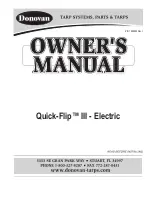
Publication: 0028607
2-1
Chapter 2
2
PRE-OPERATION
Introduction
This manual contains important information regarding
safe operation, adjustment, and maintenance for the
Super Products Camel
™
.
DO NOT allow anyone to operate or service this machine
until they have read and understood all aspects of this
manual.
DO NOT use this machine for any purpose or application
other than those listed in this manual. Improper use or
neglect of safety precautions will cause serious injury or
death. Refer to Section 1, Safety.
NOTE
This operator’s manual is to stay with the truck and
be used as reference for operator personnel.
Principles of Operation
The Camel is designed as a combination vacuum and
high-pressure water jetting sewer and catch basin
cleaning system that can also be used for select material
transferring operations. The Camel uses a water system
to break up the material and a vacuum system to remove
the material.
Definitions
• Road Mode — Used for driving the truck. Work
mode functions are not operable when this mode is
selected.
• Work Mode — Applies hydraulics for the boom,
body, hose reel, tailgate, and ejector plate functions.
The truck cannot be driven when work mode is
selected.
• Vac Mode — Used to run the vacuum pump function
after work mode has been enabled. The boom, hose
reel, and water pump are also enabled in vac mode.
• Dump Mode — Used to dump and/or eject debris
from the body, which includes the ejector plate
compaction/dewatering function. The body, tailgate,
and water pump are also enabled in the dump mode.
• Winter Recirculation Mode — Allows the water
pump to circulate water at low pressure while in road
mode, work mode, vac mode, or with truck parked
and engine idling.
The vacuum system utilizes a positive displacement
vacuum pump (1) driven by the truck engine via the
transfer case. Material is picked up at the open end of the
vacuum hose (2) and transferred into the debris body (3).
The vacuum hose is supported by a boom that can be
raised, lowered, extended, retracted, and rotated left or
right at the operator’s discretion. As material and air enter
the debris body, the majority of the material falls out into
the debris body because of gravity and the tremendous
reduction in air velocity.
Air that was allowed to enter the debris body is now
vented through an opening located on the top front of the
debris body, creating the vacuum. The opening is
equipped with a float ball (4) that prevents overflowing of
material. When the water level rises to a certain point, the
float ball closes off the opening. Once the opening is
closed and air is no longer able to exit the collector body,
the vacuum pressure is depleted.
Any remaining airborne material or mist is drawn through
a hose and enters the centrifugal separator (5) located
just in front of the debris body on the left (driver’s) side of
the truck. Centrifugal force separates the airborne
material from the air stream, allowing the material to fall
to the bottom of the separator. The air exits through the
top of the separator and enters a ten-micron final filter
(6), which captures any remaining material particles.
The clean air now enters a vacuum pump and exits
through a high-efficiency exhaust silencer (7) into the
atmosphere.
Summary of Contents for Camel 1200 (Dump Body)
Page 1: ......
Page 2: ......
Page 4: ......
Page 62: ...1 52 Publication 0028607 SAFETY 1...
Page 64: ...2 2 Publication 0028607 PRE OPERATION 2 Figure 2 1 Figure 2 2 1 3 2 5 6 4 7...
Page 106: ...4 18 Publication 0028607 SEWER CLEANING TYPICAL SEQUENCE 4...
Page 118: ...5 12 Publication 0028607 WATER RECYCLING SYSTEM 5...
Page 132: ...6 14 Publication 0028607 LUBRICATION AND MAINTENANCE 6...
Page 156: ...i vi Publication 0028607 IX...
Page 157: ......






































